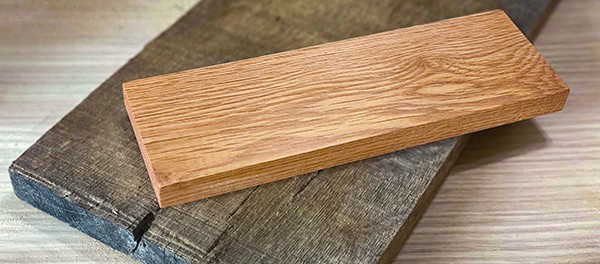Wood

Wood
All my life, I’ve enjoyed working with wood — from the homemade slingshot that gave birth to untold mischief, to the Pinewood Derby cars that looked cool but never won the race, to rebuilding dilapidated but historically significant buildings. Woodworking is a relaxing and fulfilling hobby. It does, however, require a fairly sizeable cache of tools as well as the experience to use them judiciously.
I’ve always contended that “Experience” is the mistakes we’ve made at someone else’s expense. But the hardest learned, and longest lasting, lessons come out of our own suffering. If you want to know how experienced a woodworker is, just count their fingers. Anyone who’s spent a considerable amount of time in the use of woodworking tools is short at least a portion of a digit or two.
Years ago, when I was in college, I learned just how quickly a table saw can bite while working in a wood shop after an all-nighter. Even a decade after that painful lesson, I still managed to lower my guard and interrupt the flightpath of a chunk of wood my table saw kicked back my way. In less than half a second, I re-learned the importance of vigilance.
Tools of the trade
Ask my wife and you’ll discover that I’ve invested an inordinate amount of money in woodworking tools over the years. I always purchase commercial tools rather than the cheap Christmas specials at big-box stores. Because of that, some of the tools I regularly use have been in my shop for forty-plus years. A few of my tools even belonged to my father, before I was born.
Pretty much any woodworker will attest that a good table saw is the most versatile tool you can own. If you’ve ever asked the teenage employee at Home Depot to cut a piece of plywood for you, only to find that his/her standards of accuracy were a bit more lax than your own, you understand the value of cutting your own lumber.
My table saw is one of the best in the business and I’ve been using if constantly since purchasing it new in 1981. It will make straight cuts or mitered cuts in one-degree increments, and it easily slices its way through a 2-1/2” thick slab of hardwood. But believe it or not, that’s not my favorite tool in the shop.
I have an old 15” surface planer that I bought second-hand back in the early 1990’s. It’s equipped with a large electric motor and will shave up to one-eighth inch of wood from a 14-inch-wide piece of raw lumber in a single pass. Needless to say, it’s loud and I only use it on large pieces of lumber when I want to retaliate against my neighbor for his early Saturday morning leaf blowing.
What I really like best about planing raw lumber — apart from the significant cost savings — is that you start with a nasty-looking piece of seemingly rotted timber, sporting an outer coat of gray, oxidized wood, and end up with a smooth chunk of nature that showcases the artistry of the very Author of the universe — artwork that stayed hidden beneath tree bark for up to a hundred years.
There’s just something about feeding that gnarly, beat-up piece of gray junk into one end of the planer and watching the intricately designed masterpiece emerge from the other end. Even if that wood has been stacked in a barn for twenty years — provided that the termites haven’t feasted on it — once you plane away the protective oxidation, there’s a pristine and unique creation, just daring you to deny the visionary intelligence behind its design.
The Real Story
You probably already guessed that I didn’t set out to write only about wood. What I find even more fascinating than wood is people. Most of the people I meet are just as gnarly and beat-up and discarded as that barn wood. Their real beauty is disguised beneath a layer of anger about politics or bitterness about perceived injustices, to the point that their miracle of creation is camouflaged beyond recognition.
I already know what you’re saying in your head; “pot/kettle” and “Get the log out of your own eye.” You’re exactly right! I am every bit as buried beneath a protective layer of personal oxidation as the next person. And that next person could even be you.
My question is, “Where do we find a planer that shaves the protective hypocrisy and anger off of us all, so that strangers can see the work of the Artist beneath our battered façades?”
 Let’s talk. I’d really like to hear what you have to say, and it might even give me something to write about. Email me at guy@lawsoncomm.com.
Let’s talk. I’d really like to hear what you have to say, and it might even give me something to write about. Email me at guy@lawsoncomm.com.
I’ll buy you coffee and we can compare notes. I promise not to steal your ideas without permission.
![]()
The scientist is possessed by the sense of universal causation. His religious feeling takes the form of a rapturous amazement at the harmony of natural law, which reveals an INTELLIGENCE of such superiority that, compared with it, all the systematic thinking and acting of human beings is an utterly insignificant reflection.
― Albert Einstein, “The World as I See It”

Did someone forward this newsletter to you after reading it themselves? Don’t settle for that!
CLICK HERE
to get a fresh, unused copy of this newsletter sent directly to you every Sunday morning. If you decide it stinks, you can always unsubscribe.
Everybody Matters
— Bob Chapman

I’d venture to say that I’ve read close to a hundred books about business relationships. Like my cynical friend, Perry, once told me, they’re basically about wheedling more productivity out of people. If I had to throw them all out except for one, “Everybody Matters” would be the keeper because Chapman is not about getting the most out of your employees and friends. He’s about seeing them as the unique and valuable creations they are and letting that philosophy drive every aspect of your life.
A meeting of great minds who think alike












